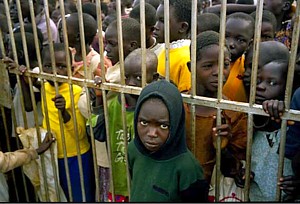Annotated Bibliography (back
to top)
- Hostile to Democracy: The Movement System and Political Repression
in Uganda. New York: Human Rights Watch, 1999.
This book was written and published by the Human Rights Watch, which
is a non-government organization that helps oppressed people around
the world. Although it provides a good amount of information on the
history, politics, leadership, and NGO involvement in Uganda, it is
biased against the Ugandan leadership for its crimes against humanity.
The book ends with a chapter encouraging involvement in Uganda in order
to help advocate human rights.
- Leggett, Ian. Uganda. Oxford: Oxfam Fountain Publishers, 2001.
- Otika, Peter. "The Acholi of Uganda Face Starvation and Genocide."
The Black Commentator. 3 November 2005. http://www.blackcommentator/93_otika.html
The Black Commentator is an online resource that is based out of Jenkintown
Pennsylvania. The author of this article, Peter Okema Otika, is the
president of the African Students Association at the University of Pittsburg.
He is also a good first hand source of the information because he is
an Acholi from northern Uganda.
- http://lcweb2.loc.gov.frd.cs.ugtoc.html
This site is from the Federal Research Division of the Library of Congress.
This organization was created in order to provide research information
to US citizens about foreign countriesí histories and current affairs.
The site as a whole was updated recently on November 9, 2005, but the
Ugandan sites I looked at had not been updated since December of 1990.
A number of different authors contributed to the Uganda site and created
detailed reports on various topics such as: Ugandan history, society,
the economy, government, and national security. The website has a reliable
backing and is highly visited.
- LA Times on the Web, "Horror
in Uganda." July 1997.
The Los Angeles Times is one of the countryís most relied upon
sources of news. It covers a wide variety of news featuring everything
from sports to stories around the world. Millions of people rely upon
the Los Angeles Times every day for their information about world affairs.
- Human Rights Watch on the Web, "The
Scar of Death: Children Abducted by the Lordís Resistance Army in Uganda."
1997.
- Wikipedia:
"Lordís Resistance Army."
Wikipedia is a free-content encyclopedia, written collaboratively by
people from all around the world. The site is a wiki, which means that
anyone can edit entries simply by clicking on the edit this
page link.
- "Lordís Resistance Army." 2000. http://www.globalsecurtiy.org/military/world/lra.html
This website features reliable information about military and political
based information. Different sources throughout the world are collected
for the articles. The authors of the website have real life experience
from the Cold War in areas of technology, politics, defense, and scientific
research.
- "Uganda." http://www.imcworldwide.org/loc_ugand.shtml
The International Medical Corps focuses on medical aid to people in
need. They are currently working on relief efforts in Uganda among other
places where a vast amount of the population suffers from the HIV virus
and AIDS. The IMC is a nonprofit humanitarian organization with a lot
of hands on information about the current situation in Uganda.
- Invisible Children. Dir. Jason, Bobby, and Larren; 2005.
A 60 minute documentation on the war in northern Uganda where children
as young as the age of five years old are being forced to kidnap and
kill other children.
- New York Times: 7 articles
I found these articles at the New York Times website, www.nytimes.com.
My search yielded 919 articles and of them I selected these 7 for this
bibliography because they illustrate my claim that the media does not
portray the war in Uganda to its full extent.
- Perlez, Jane, "In AIDS-Stricken Uganda Area, The Orphans
Struggle to Survive," The New York Times, June 10, 1990.
- Perlez, Jane, "Of Sudan's Woes, War is the Worst," The
New York Times, June 19, 1998
- Perlez, Jane, "More Fighting Brings Hunger to Sudan,"
The New York Times, October 3, 1998.
- Lacey, Marc, "World Briefing: Africa: Uganda: Rebels Propose
Cease-Fire," The New York Times, October 17, 2002.
- Stevenson, Richard W., "Bush Has Praise for Uganda In Its
Fight Against AIDS," The New York Times, July 12, 2003.
- Gavin, Michael, "Uganda's Animal Kingdom," The New
York Times, June 20, 2004.
- "World Briefing: Africa: Uganda: War Cited In H.I.V. Surge,"
The New YorkTimes, June 29, 2004.
|

